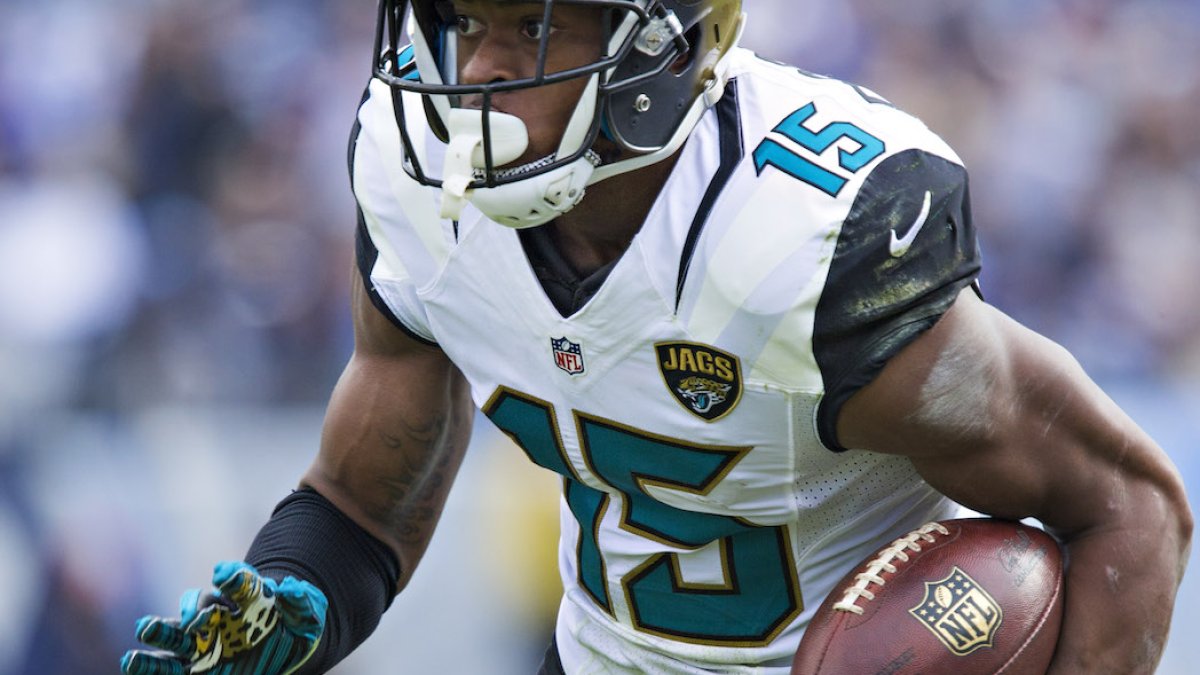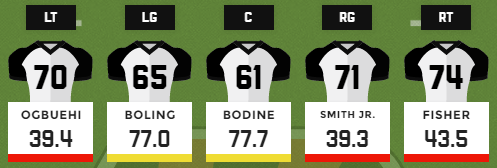On Thursday, we took a look at some of the biggest offseason moves impacting this year’s fantasy drafts. This time around, we’re going to look at the opposite. We’ll be analyzing the six worst moves that have either hindered or flat-out hurt a player or situation from a fantasy perspective.
Let’s do it.
6. Kansas City cuts Jeremy Maclin
Wrecked by terrible management of the salary cap, the Chiefs decided to let their No. 1 wideout hit the streets in favor of $10 million in savings against the cap. Maclin struggled with injuries last year with disappointing stats across the board, but was a major fantasy factor in 2015 in his first year with the Chiefs. Maclin scored 0.48 PPR fantasy points per opportunity, top-15 among all wideouts. He finished top-10 in WR Rating (115.6) and finished the season as the overall WR15 in PPR formats. He was quickly scooped up by the Ravens, where he will have a much higher ceiling, but the cap-saving move has put the Chiefs’ playoff hopes into jeopardy.
The Chiefs will now turn to Tyreek Hill as their top receiver. Hill experienced immense success on a per-touch basis last year with his 4.24 speed, but now opposing defensive coordinators will have an entire offseason to scheme for him. The depth behind Hill is barren. Chris Conley was a metric stud but we have yet to see that translate to the football field. Albert Wilson has made several splash plays throughout his short career but is also loaded with question marks. Alex Smith isn’t quite the quarterback to lead teams to victory and the Chiefs handicapped his receiving corps significantly with the loss of Maclin. Maclin’s release ultimately lowers the ceiling of the entire offense as a whole with them losing a dependable, chain-moving receiver.
5. Jets waving white flag already?
Letting Brandon Marshall and Eric Decker walk in the same offseason has turned the Jets passing offense into one riddled with question marks. Quincy Enunwa now headlines a wide receiver depth chart filled with youth and inexperience, but not much optimism for 2017. The Jets brought in Josh McCown to contend with Bryce Petty and Christian Hackenberg, and somehow, this has turned into a training camp battle to watch that we will be forced to endure this preseason. Whoever wins the starting position will likely spend most of the time facing immense pressure from opposing defenses, playing behind one of the worst lines in the league. The offensive line is in shambles, with LG James Carpenter being one of the few bright spots. The unit gave up the 11th-most quarterback hits last year (29) and have somehow downgraded to Kelvin Beachum as a replacement at LT, our 63rd-ranked tackle from last year. There will be little running room for either Matt Forte or Bilal Powell to run through, and we may need an injury to occur before either becomes fantasy-relevant as a checkdown option. By and large, it’s an undesirable situation for fantasy almost across the board.
4. Cincinnati loses two of its best offensive linemen
The Bengals lost two of their best offensive linemen via free agency this past offseason. LT Andrew Whitworth was an 11-year vet who graded out as our top pass-blocking tackle in 2016. The Rams paid Whitworth an exorbitant amount of money, where he will move on to protect Jared Goff’s blindside. Kevin Zeitler became the highest-paid guard in NFL history after signing a five-year, $60 million contract with the Browns. Zeitler graded as both a top-10 pass-blocker and run-blocker last year and his presence will be sorely missed after looking at this year’s current projected line:
The lack of talent up front could force Dalton to throw the ball much faster out of necessity in 2017. Last year Dalton ranked top-10 in average time to throw per attempt (2.37 seconds), so we’ve seen that a quick release from him isn’t outside his game. However, he may not get the luxury to utilize John Ross’ deep speed or work off play action if the line has difficulties keeping him upright. Dalton took the second-most sacks last year (41) and his line took a massive hit with the losses of Whitworth and Zeitler. Cincinnati would be wise to implement a short passing attack in 2017 to try to mitigate the loss of their two stalwart offensive linemen.
3. Dalvin Cook versus Latavius Murray
The Jerick McKinnon/Matt Asiata experiment never really took off last year, and the Minnesota front office decided to overhaul the rushing attack with some new bodies. Minnesota signed Latavius Murray to a three-year, $15 million deal with $8.55 million guaranteed. The team then drafted Dalvin Cook with the 41st overall pick and will now enter training camp with both backs contending for the top position. There’s no guarantee either emerges as a workhorse-type back, a la Adrian Peterson. That’s a scary thing for fantasy purposes, with this backfield having the potential for a full-blown committee. It’s an especially scary thing considering the Vikings have arguably a bottom-five offensive line for both these guys to run behind.
Cook has an ADP that’s soared up to RB19, a presumptuous call by the fantasy community before we ever really see him take a snap in this backfield. Ankle surgery has kept Murray off the field in OTAs, but he showed last year that he can be a fantasy thorn doing just enough to keep Oakland’s other backs from fantasy relevance. Murray was signed to a sizeable contract that included the 10th-most guaranteed money (at the time of the signing) among all running backs. Last year, neither Asiata nor McKinnon saw more than 50 percent of the team’s offensive snaps, nor saw 50 percent of the team’s collective running back touches with offensive coordinator Pat Shurmur failing to declare a bell cow. The Vikings ranked bottom-10 in plays per game and touchdowns per game, leaving low overall volume and few scoring opportunities heading into 2017. I believe rookie fever has struck fantasy drafters here in a backfield coupled with Murray sapping any true upside. The potential for a timeshare makes this backfield a tough one for fantasy footballers to pursue with much vigor.
2. Seattle’s crowded backfield
Another backfield that’s made a mess for fantasy drafters is how to handle Seattle’s running back depth chart. Eddie Lacy was signed to a one-year, $4.25 million contract and will contend for touches with C.J. Prosise and Thomas Rawls. Lacy finished with our eighth-highest elusive rating (95.4) among all running backs on limited touches last year. Prosise tied Ezekiel Elliott and Devonta Freeman in PPR points per opportunity (0.55) before injuries ended his season prematurely. A lingering ankle injury kept Rawls 2016 season hindered, but the three backs figure to duke out their roles in training camp. Current ADP has all three running backs somewhat close, with Lacy leading the way (RB26), then Prosise (RB32), and then Rawls (RB49). Last year Seattle had the team’s fewest rushing attempts in a season since 2010, but with a healthy offensive line – and more importantly a healthy Russell Wilson – we can reasonably expect the Seahawks to return to their heavy running ways. In situations like this, it may just be best to diversify exposure if playing in best-ball leagues, or go with the cheapest back until we have some clarity later this summer.
1. Jacksonville lowers Allen Robinson’s ceiling
This offseason Jacksonville has been actively trying to change their offensive identity. They’ve added Branden Albert and Cam Robinson to their offensive line. They drafted Leonard Fournette at No. 4 overall. They added some big veteran names on defense. They even picked up two fullbacks along the way.
It all adds up to an offense willing to shift into a run-first, grind-the-clock mentality in an attempt to finally contend in the AFC South. That means a potential big change in offensive philosophy — the Jaguars have finished each of the last three years seventh or higher in pass-play percentage. In fact, they rank a collective first in red-zone pass-play percentage over that time period. That heavy passing tendency has led to some outstanding volume for Allen Robinson over the past two seasons:
| Year | Targets | Rec | Yds | TD | aDOT | WR Rating | YPRR | PPR PPO | PPR Finish |
| 2015 | 142 (10th) | 80 (16th) | 1400 (6th) | 14 (1st) | 16.3 (10th) | 105.4 (24th) | 2.17 (13th) | 0.47 (17th) | 304.0 (6th) |
| 2016 | 144 (7th) | 73 (24th) | 883 (34th) | 6 (19th) | 13.9 (33rd) | 63.5 (87th) | 1.33 (65th) | 0.50 (7th) | 199.3 (24th) |
Unfortunately, last year already gave us a glimpse at the decline of Robinson’s fantasy ceiling with Blake Bortles struggling immensely (our No. 28-graded QB). Now the team wants to hide Bortles’ inefficiencies via a switch to the heavy run game. Less volume for Robinson is the exact opposite thing we want from one of our fantasy wideouts, and it’s starting to look like that’s the inevitable path for Jacksonville’s offense. A run-heavy approach by new head coach Tom Coughlin in an attempt to mitigate mistakes is a smart way to try and get his team to win football games. Unfortunately, it comes at the expense of volume for Robinson, who’s quite likely being overdrafted as the current WR14.




 © 2025 PFF - all rights reserved.
© 2025 PFF - all rights reserved.